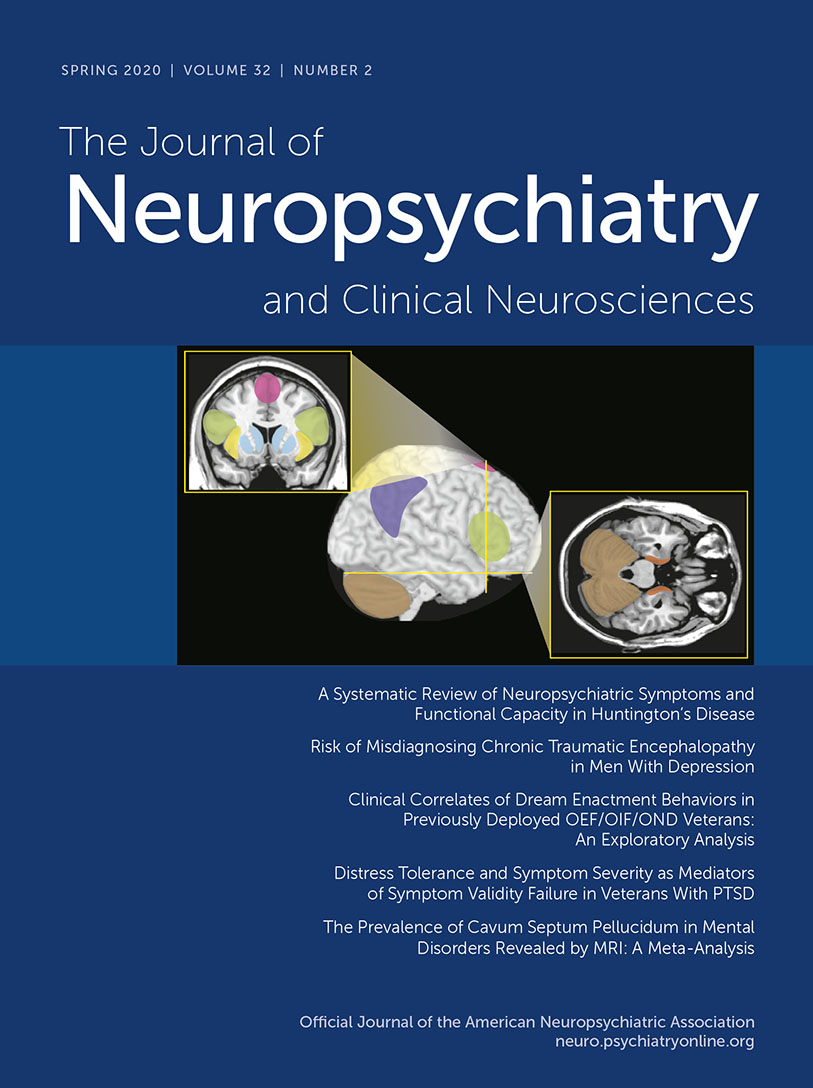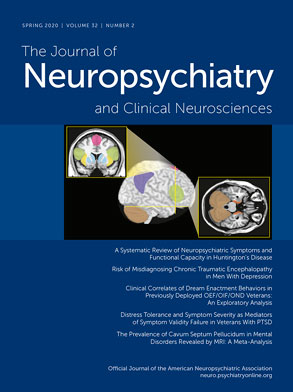Twenty-four case patients, who presented to psychiatric services from 2011 to 2018, were identified with positive serum or CSF NMDAR Ab. This represents 60% (N=24/40 cases) of all positive NMDAR Ab results tested by the laboratory, with the remaining case patients presenting to neurology or general medicine. An additional three case patients with equivocal serum NMDAR Ab, who presented to psychiatry, were identified. All subjects had both serum and CSF antibody testing, except for one equivocal NMDAR Ab case in which repeated lumbar puncture was unsuccessful. The mean time to notify the treating clinician after a positive test was 2.8 days (SD=1.5).
CSF NMDAR Ab-Positive Cases
There were 16 CSF NMDAR Ab-positive case subjects (mean age=32.7 years [SD=13.2]); female, N=10; male, N=6) (
Table 1). The mean average time for testing was 21 days after index admission (SD=27), with 11 out of 16 cases tested in <7 days. A prior psychiatric history was present for seven case patients, four of whom had a past history of anxiety or depression. Three case patients had an existing diagnosis of schizophrenia (mean time=3.3 years [SD=0.5]), with no prior neurological or speech disturbance, catatonia, cognitive deficits, or antipsychotic sensitivity; however, they had no prior anti-NMDA Ab testing. One case patient had a history of epilepsy, and four had a history of head injury. Prodromal insomnia (N=12, 75%), cognitive deficits (N=14, 87.5%), headache (N=3, 18.8%), weight loss (N=3, 18.8%), and flu-like illness (N=1, 6.3%) were reported. The average time of symptoms before presentation was 33 days (SD=41.5).
All case subjects had psychotic symptoms on admission to hospital. Delusions were described as persecutory (N=13, 81.3%), with additional unusual (N=3), religious (N=1), thought alienation (N=1), reference (N=1), and delusional jealousy (N=1) themes noted. Hallucinations were reported for 10 patients (62.5%)—auditory (N=8) and visual (N=7)—and one patient also reported olfactory, tactile, and gustatory perceptual disturbance. Disorganized thought disorder was described in 11 cases (68.8%). Affective lability (N=11, 68.8%) was more common than sustained depressed mood (N=1, 6.3%) or elevated mood (N=2, 12.5%). Affect was most commonly reported as perplexed (N=9, 56.3%). Other psychiatric features described include change in personality (N=13, 81.3%), anxiety (N=12, 75%), odd/unusual behavior (N=11, 68.8%), and pathological laughter/crying (N=4, 25%). Agitation (N=13, 81.3%), suicidal ideation/attempts (N=4, 25%), and aggression/harm to others (N=4, 25%) were frequently reported. These psychiatric features were all present on hospital admission, with only one patient showing further symptom development (auditory hallucinations commencing during the second week of admission).
Comparatively, five of the 12 patients with catatonia presented with symptoms on admission, and the other seven developed symptoms during the first 2 weeks in the hospital. The mean average on the Bush-Francis Catatonia Rating Scale at presentation was 4.3 [SD=3.4], with a peak at 10.9 [SD=4.4], at a mean average of 10.1 days (SD=10.5). The most common catatonic symptoms were as follows (in descending order of their frequency): immobility, perseveration, staring, withdrawal, impulsivity, mannerisms, stereotypy, increased activity/excitement, and mutism. Catatonia was reported as rapidly fluctuating in six patients (54.5% of catatonia cases).
Other key features on hospital admission were disturbance of speech and cognition. Speech disturbance (N=12, 75%) was most commonly described as reduced output (N=8), dysphasic speech (N=8), or mutism (N=5), with some patients having more than one disturbance. Cognitive deficits on admission were observed in 14 patients (87.5%), with some patients having more than one deficit: confusion (N=12), memory disturbance (N=10), executive dysfunction (N=10), and disorientation (N=7). In an additional case, significant memory and executive dysfunction were described 14 days after admission.
Further progression of illness with neurological symptoms occurred in 13 patients (81.3%). Seizures developed in 10 patients (62.5%), with a mean average time of 20.1 days (SD=20.4) from hospital admission. Movement disorders were noted in 11 patients (68.8%), with a mean average time of 15.6 days (SD=10.9) from hospital admission, including dystonia (N=7), rigidity (N=7), orofacial dyskinesia (N=5), hyperreflexia (N=5), and chorea (N=4). Autonomic disturbance was reported in nine patients (56.3%)—most commonly alterations to blood pressure (N=5), tachycardia (N=4), and hypoventilation (N=4)—with a mean average time of 16.2 days (SD=7.2) from hospital admission. Episodic or sustained decreased consciousness occurred in seven patients (43.8%). All anti-NMDAR encephalitis symptom clusters were present in six patients (37.5%), and in two of these cases (12.5%), the symptoms were not neurological or autonomic and considered isolated psychiatric presentations.
The mean average time to CSF diagnosis from presentation was 37.1 days (SD=46.9). Both serum and CSF were positive in 15 out of 16 cases (93.8%). It is noteworthy that one patient who was negative on initial CSF NMDAR Ab testing became CSF positive after 90 days. CSF pleocytosis was observed in four patients (25%), elevated protein was observed in two (12.5%), and oligoclonal bands were seen in two out of seven tested. No patient had other antineuronal antibody positivity or an elevated IgG index. Brain MRI was abnormal in five out of 13 patients (38.5%; three patients with temporal T2-fluid-attenuated inversion recovery abnormality, one patient with cerebellar atrophy, and one patient with hippocampal dysembryoplastic neuroepithelial tumor), and EEG was abnormal in six out of 15 (40%), all with diffuse mild-to-moderate slowing. An ovarian teratoma was found in two patients (12.5%) with no other malignancies.
Fourteen patients (87.5%) were taking antipsychotic medications—most commonly olanzapine (N=8), risperidone (N=6), quetiapine (N=4), and aripiprazole (N=4)—with 10 patients (62.5%) requiring more than one antipsychotic. Extrapyramidal side effects were noted in five patients (31.3%), all of whom were prescribed olanzapine, and suspected neuroleptic malignant syndrome was noted in two cases (12.5%; risperidone, N=1; zuclopenthixol acetate, N=1). There was minimal to no improvement of symptoms with antipsychotics. Lorazepam challenge was given unsuccessfully for five patients with catatonia; of these, two patients showed partial improvement after ECT.
Intensive care admission was required in four cases (25%). One patient did not receive immunotherapy and showed resolution of psychiatric and mild movement disorder symptoms with psychotropics. The other 15 patients were treated with intravenous immunoglobulin (IVIg) (N=14), intravenous steroids (N=8), plasmapheresis (N=4), rituximab (N=9), cyclophosphamide (N=4), or mycophenylate (N=2).
Full recovery was noted in five cases (31.3%), with the remaining patients reporting partial improvement (N=11, 68.8%). Ongoing symptoms included behavioral disturbance (N=8), cognitive deficits (N=6), and neurological deficits (N=3). Amnesia for the acute illness was reported for seven patients (43.8%). Recurrence of encephalitis occurred in four cases (25%). The mean length of follow-up was 573 days (SD=550).
CSF NMDAR Ab Negative Cases
There were eight patients (women, N=5; men, N=3)—with a mean age of 32.4 years (SD=9.8)—in which a serum NMDAR Ab was detected with a negative CSF NMDAR Ab test. The mean average time to initial testing was 2.8 days from index hospital admission (SD=2.8) and CSF testing at 18 days (SD=11), with six out of eight patients having further repeated serum antibody testing later in their illness course. There were an additional three patients who had equivocal serum NMDAR Ab positivity and a negative CSF NMDAR Ab.
The pattern of clinical presentation was clinically distinct in two of these cases, with a clinical picture of encephalitis (
Table 1). These two patients presented with an acute onset of symptoms with no psychiatric history but a prodromal flu-like illness and insomnia in the weeks before hospital presentation. Both patients experienced rapid development of catatonia within the first week of admission (peak mean Bush-Francis Catatonia Rating Scale score, 14), and one patient reported rapidly fluctuating catatonia. Both patients described reduced and dysphasic speech as well as significant cognitive (memory and disorientation) deficits. Within the second week of admission, these two patients had developed a movement disorder and features of autonomic instability. Extrapyramidal side effects with antipsychotic medication were reported for both patients. For one patient, the medication was discontinued as a result of suspected neuroleptic malignant syndrome. This patient later required intensive care admission for decreased consciousness. Neither patient had any abnormal investigation (CSF, MRI, or EEG). Both patients received immunotherapy (one with IVIg alone and one with IVIg and steroids) demonstrating rapid improvement of symptoms with only mild cognitive ongoing deficits.
The other six patients reported only psychiatric symptoms with no development of catatonia (mean average peak on the Bush-Francis Catatonia Rating Scale, 1.6), cognitive concerns, or speech disturbance. Two patients had a history of a psychiatric disorder (schizophrenia, N=1; emotionally unstable personality disorder, N=1). Three patients had an abnormal EEG with increased fast activity that was believed to be medication related. There were no abnormal CSF or MRI investigations. There was improvement of symptoms with antipsychotic medications in five of the six cases, with no side effects noted. For the one patient whose symptoms did not improve with antipsychotic medication alone, IVIg was trialed with no benefit. The other patients did not receive immunotherapy. The mean average follow-up time was 319 days (SD=248.9).
There were three patients with equivocal serum NMDAR Ab positivity with a negative CSF antibody test. All three patients had a history of schizophrenia or schizophreniform psychosis and were admitted with a psychotic deterioration with associated depressed mood or anxiety. None of the three developed catatonia, speech disturbance, cognitive deficits, seizures, movement disorders, or autonomic symptoms. MRI and EEG were normal; however, two patients had elevated serum antinuclear antibodies, and the other had elevated IgG4. All patients were successfully treated with antipsychotic medications alone. Given the co-occurring antibodies, these three patients were further excluded from analysis.
Given the small number of CSF-negative/encephalitis-suspected cases, these were excluded from comparison. When comparing CSF NMDAR-Ab-positive and CSF NMDAR-Ab-negative/encephalitis-nonsuspected cases, three significant differences were identified: prodromal cognitive deficits (p=0.0003), speech disturbance (p=0.003), and catatonia (p=0.012). All of these symptoms were more common in the CSF NMDAR-Ab-positive group.

